|
|
Introduction |
 |
|
Brazil was discovered
by the Portuguese navigator Pedro Álvares Cabral, on April
22, 1500. Former colony of Portugal, Brazil achieved its Independence
on September 7, 1822 and became a Republic on November 15, 1889.
Brazil is the biggest
country in South America and the fifth biggest one in the world,
being Russia, China, Canada and the United States the first fourth
largest countries.
Brazil occupies an
area of 8.511.965 km², about half of South America. Its
population is estimated in 169.799.170 inhabitants (August 2000).
It has borders with all countries in South America, except Chile
and Ecuador. |
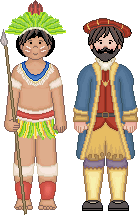 |
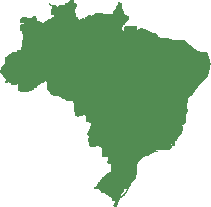 |
It borders on Uruguay
to the south; Argentina, Paraguay, and Bolivia to the south-west;
Peru to the west; Colombia to the north-west; and Venezuela,
Guyana, Suriname and French Guiana to the north, making a total
of 15.749 km of continental borders. It also has a large Atlantic
seaside (7.408 km if measured in a straight line).
The whole territory
corresponds to 47% of South America and Brazil represents 1/60
of the entire area of the planet. Brazil is formed by 26 states
and one Federal District, where Brasília, the capital
of the country is located. |
- Climate -
The climatic variations
in the country calls attention to the large territory that it
occupies. The climate is mainly tropical, with exception to the
south, which presents a subtropical climate, and a semiarid area
in the north-east. Most of the rest of the country gets a moderate
amount of rainfall.
Temperatures in Brazil
are uniform during Summer, from November to April, averaging
about 26º C (approximately 78 F) over most of the lowlands
in January, and a few degrees less in the highlands, depending
upon elevation.
This tropical characteristic
constant along the year is due to the fact that Brazil is located
between the Equator line and the Tropic of Capricorn. Above the
Equator line, we find 598.656 km² (about 7% of the whole
country) and, below the Tropic of Capricorn, 600.731 km².
- The Land Relief
- |
|
The country can be
described in terms of its highlands and lowlands, which are separated
from each other by physical barriers, being the Great Escarpment
the most impressive. The lowlands are composed of three main
regions: the Amazon lowlands, the west-central Pantanal and the
coastal lowlands, being the Amazon lowlands the largest of these.
The highest peaks
of Brazil are called Pico da Neblina (3.014,1 meters high) and
Pico 31 de Março (2.992 m), both located in the north
of Brazil. |
|
|
|
Also in the
north we find the Amazon River, the first largest river of the
world in terms of volume of water, receiving nearly 200.000 square
km of water per second, and the second one in extension - 6.280
km long (the first is the Nile river in Africa). The Amazon has
almost 1.100 tributaries, carrying more water than the Mississippi,
Nile, and Yangtze rivers combined.
The Amazon River originates
in Peru, rising from a point in the Peruvian Andes. When it enters
Brazil, it receives the name of Solimões River and it
only begins to be called the Amazon River when it joins the Negro
River. |
|
When these two
rivers merge together, they create a great spectacle. The river
becomes two-toned because the contrasting colored water still
flows for several miles before mixing together. |
|
The Amazon river,
from its spring in the Andes to its estuary in the Marajó
Island in Brazil, covers 6.868 kilometers, the same distance
between New York and Berlin. It
is navigable all the way into eastern Peru, but the tributaries
are all interrupted by falls and rapids where they descend from
the highlands.
The São Francisco
River, the largest river wholly within Brazil, is the third of
the country's great river systems. The São Francisco rises
in the Brazilian highlands in western Minas Gerais and southern
Goiás, inland from Rio de Janeiro.
- Plant and Animal
Life - |
|
Brazil is the major
producer of coffee, banana and sugarcane in the whole world.
It occupies the second position in the production of potatoes
and beans, third position in the production of corn, and soy,
fourth position in the production of peanuts, fifth position
in the production of tobacco and cotton.
Coffee is cultivated
mainly in the states of Minas Gerais, Espiríto Santo,
São Paulo and Paraná and the sugar cane plantations
are concentrated mainly in São Paulo, Pernambuco, Alagoas,
Minas Gerais and Paraná. Other important agricultural
products are rice, beans, orange, grapes etc. |
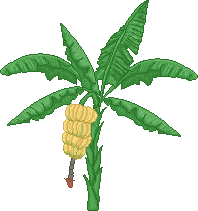 |
|
Except in the
more remote and sections of Brazil's eastern highlands, little
of the original flora and fauna remain in the greatest part of
the country.
In the Pantanal -
an area of swamps and marshes in northwestern Mato Grosso do
Sul and southern Mato Grosso states, noted for its natural beauty
and rich wildlife - the many sloughs and watercourses still support
an abundance of wildlife, including the giant "pirarucu"
(Arapaima gigas), the largest fresh-water fish, measuring
on average 4 meters in length. Wildfowl also abound in the Pantanal.
There are numerous species of snakes, including the deadly "jararaca"
and the rattlesnake, a wide variety of lizards, armadillos and
anteaters, which may stand more than six feet high. The "onça",
a type of jaguar and the ocelots have been mercilessly hunted
and are now endangered species.
The Amazonian rainforest,
in the north of Brazil, is the richest ecosystem in the country.
The rainforest and its waters have a remarkable abundance of
plant and animal life. It has the most varied plant life on Earth,
with a large number of different species of birds and the largest
variety of monkeys in the whole world. |
 |
Some 1.400 bird
species have been identified in the immediate vicinity of the
main stream of the Amazon alone. Along the riverbanks are found
alligators, anacondas, boa constrictors, "capivaras"
(Hydrochareis hydrochaeris) - a sub-aquatic animal and the world's
largest rodent, weighing on average 45 kg, with various subspecies
in South America - and a number of lesser reptiles and mammals. |
|
In the waters
themselves there are manatees, freshwater dolphins, and some
1.500 identified species of fish, with perhaps another 1.000
unidentified species; the variety includes many types of piranhas,
not all of them flesh-eating, electric eels, and some 450 species
of catfish.
The Amazon is also
home to the world's largest fresh-water turtle, of the genus
Podocnemis, extinct everywhere except in the Amazon and
on the island of Madagascar. |
 |
|
The entire indigenous
population of Brazil was estimated in 4 to 5 million in the beginning
of the Portuguese colonization. Today, this number has reduced
to 220 thousand, concentrated mostly in the North Region of Brazil.
They live in different tribes, in houses made of wood and palm
tree leaves. |

  |
Each tribe has its
own chieftain, who is in charge of everything in the community.
These people were very important to the formation of the Brazilian
culture. They contributed with food, plantation techniques and
some words from their language. |
|
The Africans,
who began to be brought to the country in 1550 as substitutes
for the Indian slave labor, also added their music, cooking and
religious practices. |
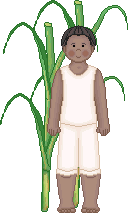 |
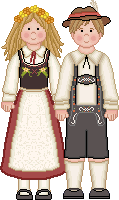 |
European immigrants,
such as Portuguese, German, Italian, Japanese, and others, also
contributed to enlarge the variety of ethnic groups which form
Brazil. |
 Almost the whole population
of Brazil is Roman Catholic. When the Africans arrived in Brazil
during the slave trade, they brought their own religions and
rituals with them, which were then prohibited while Roman Catholic
practices were enforced. But a mix of the two faiths developed
and some people still follow the two faiths.
The most popular African
religious practice is called "Candomblé" and
its followers can be found mostly in Bahia, a state in the north-east
of Brazil.
Almost the whole population
of Brazil is Roman Catholic. When the Africans arrived in Brazil
during the slave trade, they brought their own religions and
rituals with them, which were then prohibited while Roman Catholic
practices were enforced. But a mix of the two faiths developed
and some people still follow the two faiths.
The most popular African
religious practice is called "Candomblé" and
its followers can be found mostly in Bahia, a state in the north-east
of Brazil. |
- Government -
The form of government
is the Federal Republic and the President is directly elected
by the people. Voting is mandatory from 18 to 65 years of age,
except to those who are illiterate or unable to express themselves
in the national language, and optional from 16 years of age.
The president works
at the Palácio do Planalto. Congressmen and senators work
at the National Congress. The
Supreme Court Justices work at the Supreme Court. These three
buildings are situated around a large square in Brasilia, called
The Square of the Three Powers (Praça dos Três Poderes).
 |
- Language - |
 |
The Portuguese language
is spoken throughout the whole country, except among a few thousand
native "Indians" in the most remote reaches of the
Amazon River system and a few immigrants, mostly aged people,
who live inland in the south and still speak their native languages
and know little about the Portuguese language.
The Portuguese language
has undergone many changes, both in the mother country (Portugal)
and in Brazil, since it has been introduced to the country after
the colonization. Although written word remains mutually intelligible
in both countries, pronunciations, vocabularies and the meanings
of some words have diverged.
New words and expressions
in Brazilian Portuguese have been introduced by Italians, Germans,
Japanese and other immigrants, and from across the borders with
Spanish-speaking countries.
A good example is
the universal use in Brazil of the word "tchau" (good-bye),
adopted from the Italian "ciao" (the written form is
different, but the pronunciation is the same). Other words have
entered through contact with foreign products and technologies.
|
|
It is however suggested
that the greatest divergence of the Brazilian language from the
Portuguese goes back to contact with the "Indians".
The main language spoken by the tropical forest peoples of Brazil,
that is called Tupian, or "Tupí-Guaraní",
became the lingua franca between the natives and the Portuguese
traders, missionaries, adventurers and administrators.
The Tupian influence
in Brazilian place names is overwhelming, a large numer of districts,
cities, states, rivers etc, originated from the "Tupi-Guaraní",
such as Ipanema (y-panema = bad river); Tijuca (tujuco = place
wehere there is a lot of mud); Ipiranga (y-piranga = red river);
Pernambuco (para-nã-mbuca = sea with holes, this name
is due to the large number of reefs on its coast); and many others. |
As a result of the
Tupian influence, Brazilian Portuguese became more nasal than
the Portuguese spoken in Portugal and Brazilians generally speak
more slowly, pronouncing all the vowels. However, depending on
the region, Brazilian people have very different accents.
- Popular Feasts
-
Carnival is the most
traditional popular celebration in Brazil and beautiful carnival
parade that takes place Rio de Janeiro city is undoubtedely the
most popular in the whole country. |
 |
Carnival happens just
before the Lent time, the 40 days period that precede Easter.
Its date varies from year to year, but it usually ranges from
late February to early March. It officially begins on a Saturday
and ends on a Tuesday. The following Wednesday is called "Quarta-feira
de Cinzas" (Ash Wednesday). During four whole days, people
have a lot of fun in all parts of the country. In 2002 is celebrated
from February 9th to February 12th.
Samba , the main rhythm
of the Brazilian carnival, originated from the ancient rhythm
the African slaves brought to Brazil.
Brazilian carnival
has its origin in the old Portuguese pre-Lent celebration known
as the "entrudo" (from the Latim introito, which
means beginning) and it was introduced in Brazil in 1723, with
the immigration from the islands of Madeira, Açores and
Cabo Verde. |
- Sports -
 Soccer is the nation's
most popular sport, drawing huge crowds to international matches
at stadia in the major cities. The largest of these, the Maracanã
stadium in Rio de Janeiro, inaugurated in 1950 (the world's largest
stadium), has room to 200.000 people.
From Brazil came the
world-renowned Pelé, one of the greatest players of all
time, as well as the famous contemporary soccer player Ronaldo,
known in Brazil as Ronaldinho.
Soccer is the nation's
most popular sport, drawing huge crowds to international matches
at stadia in the major cities. The largest of these, the Maracanã
stadium in Rio de Janeiro, inaugurated in 1950 (the world's largest
stadium), has room to 200.000 people.
From Brazil came the
world-renowned Pelé, one of the greatest players of all
time, as well as the famous contemporary soccer player Ronaldo,
known in Brazil as Ronaldinho. |
|
Back
to the Brazilian Menu |
This
page was created on: January 24, 2002.
Last updated on: July 1, 2006.
[
Site
Menu
] [ Home ]
 |
Information obtained at: 1. The Encyclopædia Britannica (Web site)
2. Nova Enciclopédia Ilustrada Folha. Folha de São
Paulo. São Paulo, 1996.
3. TIBIRIÇA, Luiz Caldas. Dicionário de Topônimos
Brasileiros de Origem Tupi. Ed Traço. São Paulo,
1985.
~ All Artwork on this page by
Graphics by Irene ~ Background Midi "Abusou"
from Luciano's Piano Bar.
Backgrounds by: Graphics by Grace (www.graphicsbygrace.com) ~ The Mother Bear (www.themotherbear.com) ~ Rajiv's Graphics ~ |
 |
|
|